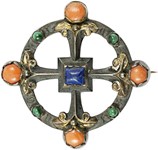
The entrance to the Berlaymont Building, headquarters of the European Commission.
Photo: Christophe Licoppe Via European Union.
Although not being introduced in Great Britain (following Brexit, the regulation was repealed except in Northern Ireland), the changes will still impact many art, antiques and antiquities dealers who trade into the European Union.
The measures, first proposed in July 2017 by the European Commission and due to come into force on June 28, 2025, were designed to stop the movement of objects illicitly exported from their country of origin and were drawn up in an attempt to stop trafficking of looted antiquities.
However, the art and antiques sector (as reported in ATG Nos 2390 and 2489) believes the proposals are unfair and overly onerous.
Trade associations working together (including CINOA, SNA, BADA, LAPADA, IADAA AND ADA) are planning the next phase in their campaign and practical steps are under way to set up negotiations with EU officials to supplement the ongoing consultation via the European Commission working group for the art market.
France’s Syndicat National des Antiquaires (SNA) hosted a media event and seminar on the law in Paris at the end of February and TEFAF Maastricht devoted its main exhibitor briefing, the annual High Expert Dialogue, to the subject on March 6.
Challenges ahead
“No one involved underestimates the challenges that lie ahead”, said Ivan Macquisten, adviser to the Antiquities Dealers’ Association (ADA) in the UK, and the International Association of Dealers in Ancient Art (IADAA), both of which have been leading the campaign on this issue since before the law was passed in 2019.
“While the law extends powers to the Commission for change, it does so in very specific areas, and these are not necessarily where the problems lie, so we have a lot of work to do to see what practical solutions are available.”
Macquisten added: “Part of the problem is that those who drafted the regulation did not have sufficient understanding of how the market works and its likely impact.”
Reality check
Mark Dodgson, secretary general of the British Antique Dealers’ Association (BADA), said: “Depending on the types of goods they sell, it will make it much harder for British dealers to sell into the EU market, whether that’s at fairs or direct to the customer.
“The regulation fails to take account of the simple fact that 99% of cultural goods, particularly old ones, are not accompanied by paperwork to demonstrate that they left their countries of origin lawfully, because most left decades if not hundreds of years ago, and we don’t usually know when that was.
“Those doing the drafting assumed that cultural goods entering the EU do so direct from their country of origin or left it in recent times, when we know this not to be the case for most items in circulation. The legislation needs to be changed to reflect this reality and we’re discussing with colleagues a number of possible solutions that could be put forward.
“If left unchanged the regulation reverses the burden of proof – it assumes that an object left its country of origin illicitly unless it can be proved that it left lawfully. It is also retroactive in nature, and this could have been avoided had it not applied to any goods shown to have left their country of origin before 2019 (the year the regulation was passed).”
An EU official told ATG: “The commission has been providing information on the new rules for import to the art market at every opportunity, in particular via the expert group ‘Dialogue with the Art Market’.”
“Non-European” art
The regulation targets the movement of “non-European” art coming into or out of the EU. Artworks originally made or found in the EU are not affected by the new rules. But those affected include pre- Columbian art, British art, Chinese art, Japanese art, Indian art, Islamic art, fossils found outside the EU, tribal art, Russian icons and Egyptian artefacts.
A new electronic system is being developed to administer the new rules and two categories of cultural goods have been created: high risk and low risk.
Importers of certain categories of cultural objects older than 200 years, originating outside the EU and valued in excess of €18,000, will have to sign an importer statement confirming that the items have been lawfully exported from their country of origin, and if stopped at the border will need to back up their declaration by providing documentation demonstrating lawful export from the country of origin (some exemptions do apply).
Importers of 250-plus year-old archaeological items (irrespective of their value) will need to apply in advance for a licence (even temporarily such as for a fair or event) and owners will need to supply that documentation with their application.











